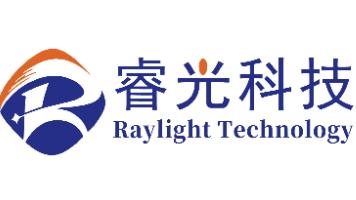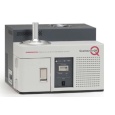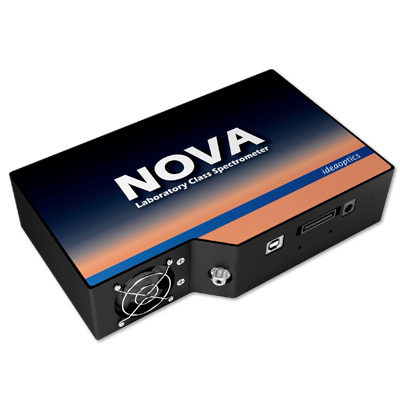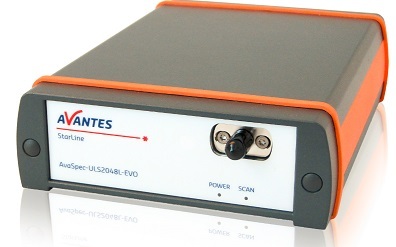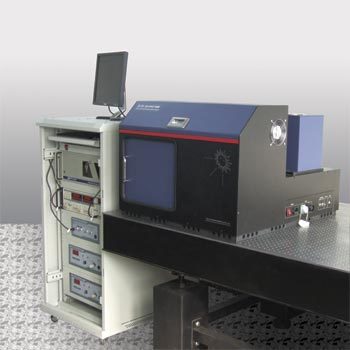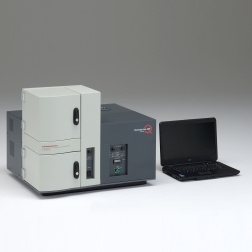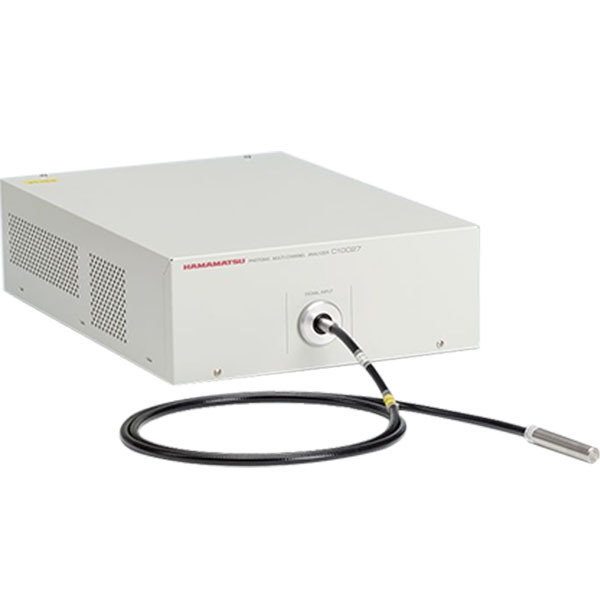
量子点是一类纳米颗粒,其中电子的能级呈现量子化、不连续的状态。当能级之间的能量差别对应可见到近红外的光子能量时,一些量子点就可以被光或者电能激发,发出可见到近红外的荧光。由于电子能级之间的能量差与颗粒尺寸相关,所以即使同一种材料的量子点,大小不同,荧光的颜色也可以不一样(如图1)。而材料本身(如CdSe、碳)、量子点的结构(如核壳结构)对其荧光特性也有着不可忽略的影响。量子点的一大应用是作为荧光探针用于生物成像;此外在显示屏幕领域,量子点可以替代LED中的荧光粉(荧光粉应用背景参考),而新一代的QLED屏幕则直接采用了能够电致发光的量子点材料。
方案详情

Measurementprocedure AnalysisfunctionsSimple-to-use dedicated quantum yield measurement software R Quantaurus-QY Absolute PL quantum yield spectrometer C11347 series Measuring absolute photoluminescence quantumyields (internal quantum efficiency) of light-emittingmaterials In developing new light-emitting materials, it is essential toimprove their photoluminescence efficiency. Improving this efficiency requires accurate techniques formeasuring the quantum yield. Quantaurus-QY includes anexcitation light source consisting of a xenon lamp and amonochromator, an integration sphere with optional nitrogengas flow, and a multichannel detector capable of simultaneousmulti-wavelength measurement, which are all integrated into asingle package. The system utilizes dedicated software formaking the measurements.. The detector isaa(cooled.back-thinned CCD sensor and so makes instantaneousmeasurements with high sensitivity. Quantaurus-QY handles solution, thin-film and powdersamples, and it can cool solution samples down to liquidnitrogen temperature. Features Measures absolute photoluminescence quantum yieldoflight-emitting materials (PL measurement) Utilizes an integrating sphere to measure all luminous flux Cooled, back-thinned CCD sensor allows measurementswith ultra-high sensitivity and high S/N ratio Automatically controls the excitation wavelengths Space-saving, compact design Wide selection of analysis functions ·Photoluminescence quantum yield ·Excitation wavelength dependence .Photoluminescence spectrum Instantaneous measurement The multichannel detector captures the sensitivity-compensated spectrum, and calculates the quantumyield in a process that instantaneously finds the absolute value of the quantum yield.Dialog-style dedicated software keeps the measurement process simple. Fully automated hardware The software-controlled monochromator allows selecting excitation wavelengths so that the sample canbe excited by various excitation wavelengths. Wavelength dependence of quantum yields and excitationspectrum can then be automatically measured. Analyzing different sample forms Quantaurus-QY handles solution, thin-film, and powder samples. With a Dewar flask holder, solutionsamples can be cooled by liquid nitrogen to -196C (77K). 2 models available Two product types are provided according to the wavelength range for sample excitation andphotoluminescence: one covers a spectral range from 300 nm to 950 nm and the other from 400 nm to1100 nm. Standard NIRC11347-11 C11347-12wavelength wavelength300 nm to 950 nm 400 nm to 1100 nm Quantum yield measurements are made in a wide range of fields tomeet needs in development and research applications. Typicalapplications include improving quality in various types oflight-emitting materials such as organic EL materials, white LED,and phosphors for FPD; researching organic metalcomplexes; evaluating fundamental characteristics ofdye-sensitized solar cells; and measuring fluorescentprobe efficiency in biological fields. = photoluminescence spectrum measurement example The dedicated software ensures simple and rapid measurements. This screen shows the dependence of PL quantumyield on excitation wavelength. Excitation spectra can be measuredby using amotorized excitation monochromator. A PL spectrum is displayed after subtraction ofresidual excitation light components. A spectrummeasuredby Quantaurus-QYalwayscontainsexcitation light which was not absorbed by the sample.The software offers a function for removing theseremaining excitation light components and enables theuser to show a purified emission spectrum. This is a basic screen for quantum yield measurements.The luminescence quantum yield is automaticallycalculated after measurement. Excitation and emissionbands are defined by adjusting the cursors. The value ofthe quantum yield is displayed in the table below thespectrum next to emission intensities, peak wavelength,peak counts, and peak band (FWHM). Besides displaying PL spectra and calculating quantumyields, the software also includes a function for colorcoordinates. Besides the chromaticity coordinates (x, y) ofthe measured sample, the three stimulus values (X, Y, Z)are displayed. Measurementexamples Our long and proven record in quantum yield measurements is the reason ourproducts are favored by many users in a wide range of fields. Re-evaluation of photoluminescence quantum yield of representative standard solutions The quantum yields of fluorescence standard solutions were measured with our Absolute PL quantum yieldmeasurement system. The fluorescence standard solutions have been used for determining PL quantumyield based on a relative method. For the most compounds, the quantum yield measured by our systemshows excellent agreement with the values given in the literature, proving the high reliability of our system. Figure: Fluorescence spectrum and quantum yield of anthracene solution Collaborative research of Hamamatsu Photonics K.K.; A. Kobayashi, S. Kaneko, K. Takehira, T. Yoshihara, and S. Tobita, Faculty of Engineering, Gunma University; H.Ishida, Y.Shiina,and S.Oishi, School of Science, Kitasato University K. Suzuki, A. Kobayashi, S. Kaneko, K. Takehira, T. Yoshihara, H. Ishida, Y. Shiina, S. Oishi, and S. Tobita,Phys. Chem. Chem. Phys., 11,9850 (2009). Quantum yield measurement of fluorescent bioprobe Fluorescent probe for enzyme reaction detection: Quantum yield provides a comparative measurement. Fluorescent probe TG (Tokyo Green)-BGal for B-galactosidase activity detection is nonluminescent (Q=0.01) but exhibits strong fluorescence after reacting with β-galactosidase. The quantitative difference in amounts of light emitted before and after the enzyme reaction can be found by comparing their quantum yields 中. We also offer a lineup of quantum yield measurement systemsallowing diversified material evaluations on the same sample. Fluorescence Lifetime and Absolute PL Quantum Yield There are two processes when substances are excited by light irradiation from the ground state to excitedsinglet state (S1), then deactivated to the ground state again. One is radiative process such as fluorescenceor phosphorescence, and the other one is a non-radiative process released as heat. The fluorescence lifetime t (tau) is defined as where kf is the radiative rate constant and knr is the non-radiative constant. On the other hand, the PL Quantum Yield (中) is expressed as the ratio of the number of photons emittedfrom molecules (PNem) to that absorbed by molecules (PNabs). D=PNem/PNabs However the PL Quantum Yield中is also written as Thus, there is a close relationship between 中(tau) and )中 as shown in the following equation,and they are very important parameters for controlling the emission mechanisms of the materials. kf=中/T A diversified evaluation of the luminescence materials is now available! Newly developed Quantaurus-Tau for measuring fluorescence lifetime and Quantaurus-QY for absolute PLquantum yield with simplified and minimized operating procedure are now available for everybody.Combination of Quantaurus-Tau and Quantaurus-QY allow users to obtain complementary analysis results. RQuantaurus-TauFluorescence lifetime spectrometer C11367 series Absolute PL quantam yield spectrometer C11347 series Type number C11347-11 (Standard type) C11347-12 (NIR type) PL measurement wavelength range 300 nm to 950 nm 400 nm to 1100 nm Monochromatic light source Light source 150 W xenon light source Excitation wavelength 250 nm to 850 nm 375 nm to 850 nm Bandwidth Excitation wavelength control Automatic control Multichannel spectroscope Measurement wavelength range 200 nm to 950 nm 350 nm to 1100 nm Wavelength resolution <2 nm <2.5 nm Number of photosensitive device channels 1024 ch Device cooling temperature -15°C AD resolution 16 bit Spectroscope optical arrangement Czerny-Turner type ntegrating sphere Material Spectralon Size 3.3 inch Software Measurement items PL quantum yield Excitation wavelength dependence of quantum yield PL spectrum (peak wavelength, FWHM) PL excitation spectrum Color measurement (chromaticity, color temperature, color rendering index, etc.) Quantaurus-QY is registered trademark of Hamamatsu Photonics K.K. (EU, Korea, Japan, U.S.A.) Quantaurus-Tau is registered trademark of Hamamatsu Photonics K.K. (EU, Korea, Japan, U.S.A.) Product and software package names noted in this documentation are trademarks or registered trademarks of their respective manufacturers. ·Subject to local technical requirements and regulations, availability of products included in this promotional material may vary. Please consult your local sales representative. · Information furnished by HAMAMATSU is believed to be reliable. However, no responsibility is assumed for possible inaccuracies or omissions.Specifications and external appearance are subject to change without notice. C2016 Hamamatsu Photonics K.K. HAMAMATSU PHOTONICS K.K. www.hamamatsu.com HAMAMATSU PHOTONICS K.K., Systems Division 812 Joko-cho, Higashi-ku, Hamamatsu City, 431-3196, Japan, Telephone:(81)53-431-0124, Fax: (81)53-435-1574, E-mail: export@sys.hpk.co.jp U.S.A.: Hamamatsu Corporation: 360 Foothill Road, Bridgewater, NJ 08807, U.S.A., Telephone:(1)908-231-0960, Fax:(1)908-231-1218 E-mail: usa@hamamatsu.com Germany: Hamamatsu Photonics Deutschland GmbH.: Arzbergerstr. 10, D-82211 Herrsching am Ammersee, Germany, Telephone: (49)8152-375-0,Fax: (49)8152-265-8 E-mail:info@hamamatsu.de France: Hamamatsu Photonics France S.A.R.L.: 19, Rue du Saule Trapu, Parc du Moulin de Massy, 91882 Massy Cedex, France, Telephone: (33)169 53 7100, Fax: (33)1 69 53 71 10 E-mail: infos@hamamatsu.frUnited Kingdom: Hamamatsu Photonics UK Limited: 2 Howard Court,10 Tewin Road, Welwyn Garden City, Hertfordshire AL7 1BW, UK, Telephone: (44)1707-294888, Fax: (44)1707-325777 E-mail: info@hamamatsu.co.uk North Europe: Hamamatsu Photonics Norden AB: Torshamnsgatan 35 16440 Kista, Sweden, Telephone: (46)8-509-031-00, Fax: (46)8-509-031-01 E-mail: info@hamamatsu.se Italy: Hamamatsu Photonics Italia S.r.l.: Strada della Moia, 1 int. 6, 20020 Arese (Milano), Italy, Telephone:(39)02-935-81-733, Fax: (39)02-935-81-741 E-mail: info@hamamatsu.itChina: Hamamatsu Photonics (China) Co., Ltd.: 1201 Tower B, Jiaming Center, 27 Dongsanhuan Beilu, Chaoyang District, 100020 Beijing, China, Telephone: (86)10-6586-6006, Fax:(86)10-6586-2866 E-mail: hpc@hamamatsu.com.cn Taiwan: Hamamatsu Photonics Taiwan Co., Ltd.: 8F-3, No.158, Section2, Gongdao 5th Road, East District, Hsinchu, 300, Taiwan R.O.C. Telephone: (886)03-659-0080, Fax: (886)07-811-7238 E-mail: info@tw.hpk.co.jp 应用背景——量子点与关键参数量子点是一类纳米颗粒,其中电子的能级呈现量子化、不连续的状态。当能级之间的能量差别对应可见到近红外的光子能量时,一些量子点就可以被光或者电能激发,发出可见到近红外的荧光。由于电子能级之间的能量差与颗粒尺寸相关,所以即使同一种材料的量子点,大小不同,荧光的颜色也可以不一样(如图1)。而材料本身(如CdSe、碳)、量子点的结构(如核壳结构)对其荧光特性也有着不可忽略的影响。量子点的一大应用是作为荧光探针用于生物成像;此外在显示屏幕领域,量子点可以替代LED中的荧光粉(荧光粉应用背景参考),而新一代的QLED屏幕则直接采用了能够电致发光的量子点材料。图1. 量子点荧光随尺寸的变化示例通常而言,量子点的发射光谱较窄(颜色比较纯净),量子产率较高(比较亮);在量子点的研究中,首先会关注其光谱特征和量子产率;在一些情况下,电致发光效率和荧光寿命也是需要被测量的参数。# 光谱无论是用作生物荧光探针还是用在显示屏幕中,量子点的发射光谱和激发光谱都是基本的特性。对于显示器应用,量子点狭窄的发射光谱可以带来较为“纯净”的“单色光”,有利于基于RGB三原色的色彩表达。而在生物荧光成像应用中,亮度高、不淬灭的近红外荧光量子点,结合近红外光对组织的高穿透性,也逐渐成为深层组织成像的利器。# 量子产率材料发出光子的数目与所吸收光子数目的比值称为量子产率。量子产率很大程度上反应了材料对激发光的利用效率,而量子点一个很大的优势就是高量子产率(通俗说来就是比较亮)。但传统上许多高量子产率的量子点都含有镉(Cd)元素,对环境的污染比较严重。所以用非Cd的材料做出高量子产率量子点的研究正受到越来越多的关注。宽广的光谱测量在生物荧光探针等应用的量子点研究中,不仅需要测量可见光区的光谱,还可能需要测量近红外红外光的光谱。为了契合这样的需要,滨松Quantaurus-QY plus中不仅配备了高灵敏度高信噪比背照式CCD探测器(探测范围从紫外至约1100nm的近红外,如图2上左),而且配备了专门用于近红外波段的InGaAs探测器(从850nm至1650nm,如图2上右)。作为在光电行业深耕细作几十年,光探测器产品线非常宽广的技术型公司,滨松在Quantaurus系列产品中均选用了自产的探测器。并基于对探测器的深刻理解与定制,开发出了“光谱无缝缝合”技术,使得通过可见光探测器和近红外探测器所得到的光谱能够衔接在一起(如图2),从而使用户可以在350-1650nm的范围内,横跨可见及近红外区域得到完整的光谱和真实的量子产率数值。(如图3)图2. 从可见到近红外连续光谱测量的双探测器方案图3. 文献案例:横跨可见到红外的光谱测量。500nm左右的峰为吸收光谱,1300nm左右的峰为发射光谱。(N. Hasebe, et al. Anal. Chem. 87 (2015), 2360)量子产率的测量滨松量子产率测试仪对上至百分之一百,下至百分之一以下的量子产率都具有非常准确的测量能力(如图4)。图4. 滨松量子效率分析仪对一些标准样品的测试值与文献值的对比(K. Suzuki, et al. Phys. Chem. Chem. Phys. 11 (2009), 9850)为了得到结果,除了在硬件方面精益求精,滨松也一直在研究量子产率测量中的各种误差来源。比如对于许多量子点,激发光谱和发射光谱会有所重叠(如图5);这意味着量子点发出的荧光有可能被自身再次吸收——这种自吸收(reabsorption)现象会导致量子产率的测量值低于真实值,而且越浓的溶液低估得越厉害(如图6)。针对这种低估量子产率的可能,滨松运用了对应的自动测量流程及算法(K. Suzuki, et al. Phys. Chem. Chem. Phys. 11 (2009), 9850,本文一作即为负责相关产品研发的滨松工程师)保证得到准确的量子产率读数(如图6)。图5. 几种量子点的吸收及发射光谱。实线为吸收光谱,多点连线为发射光谱;蓝绿黑红对应着量子点尺寸从小到大。(U. Resch-Genger, et al. Nat. Methods 5 (2008), 763)图6. 自吸收(Reabsorption)校正结果示例(K. Suzuki, et al. Phys. Chem. Chem. Phys. 11 (2009), 9850)
确定

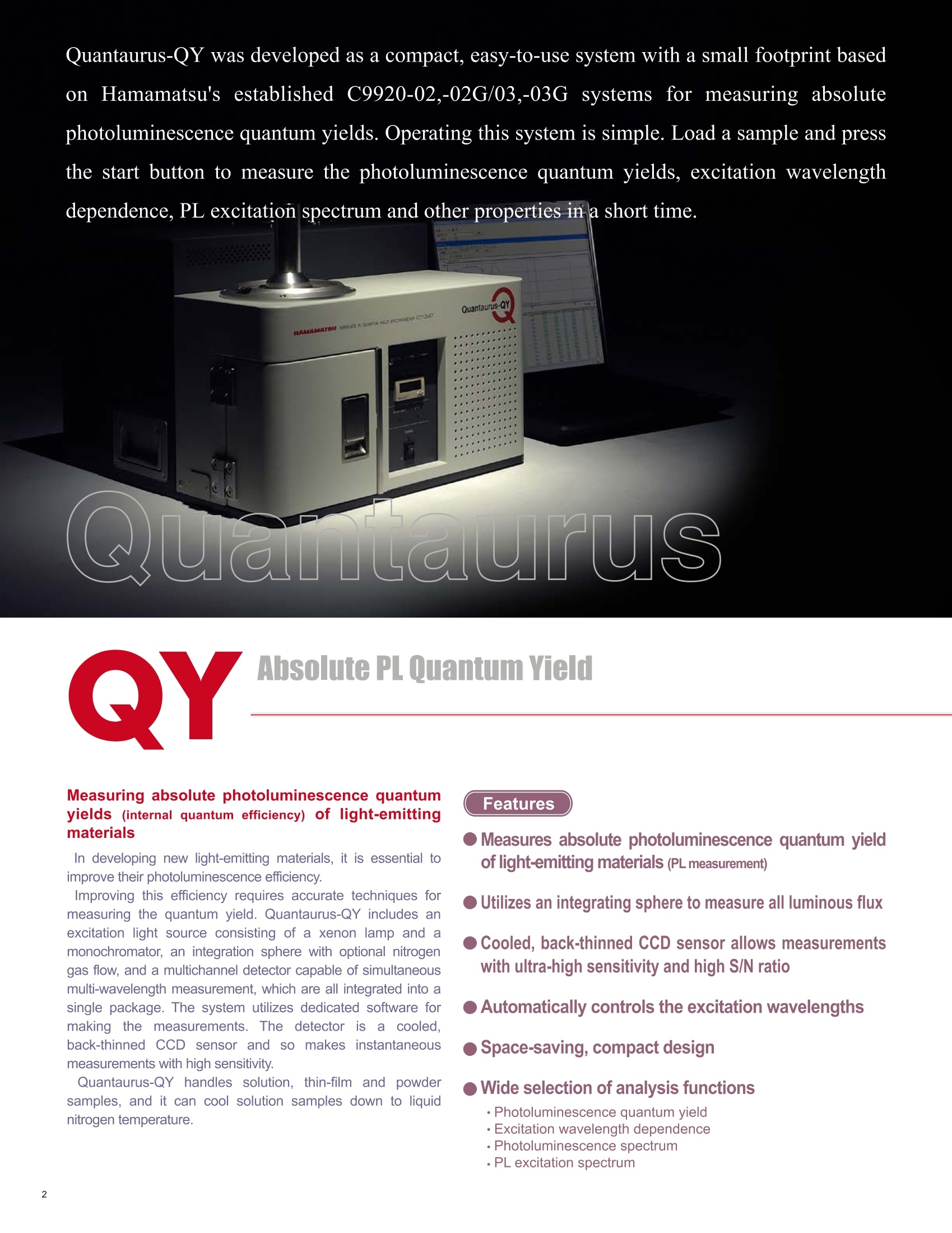
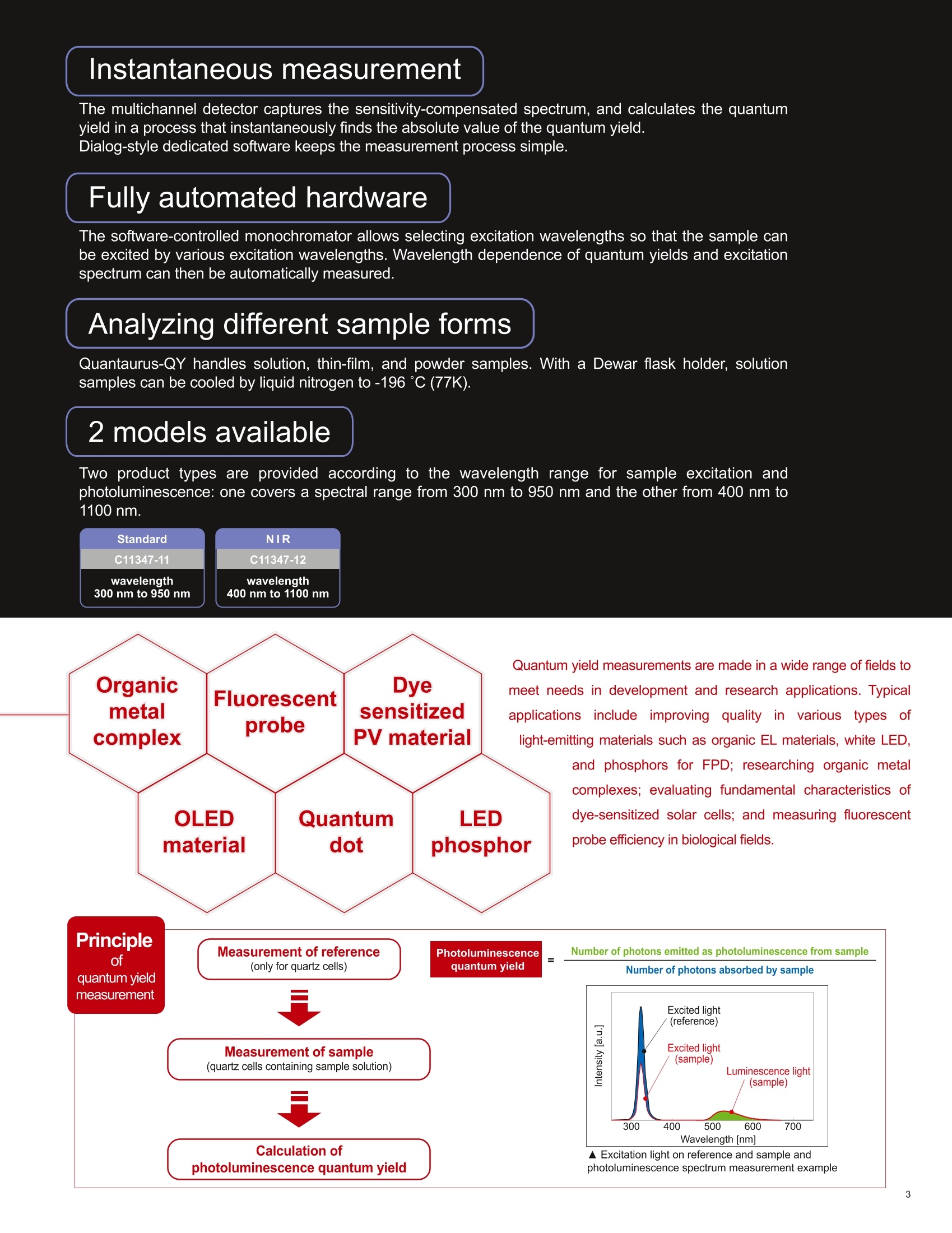
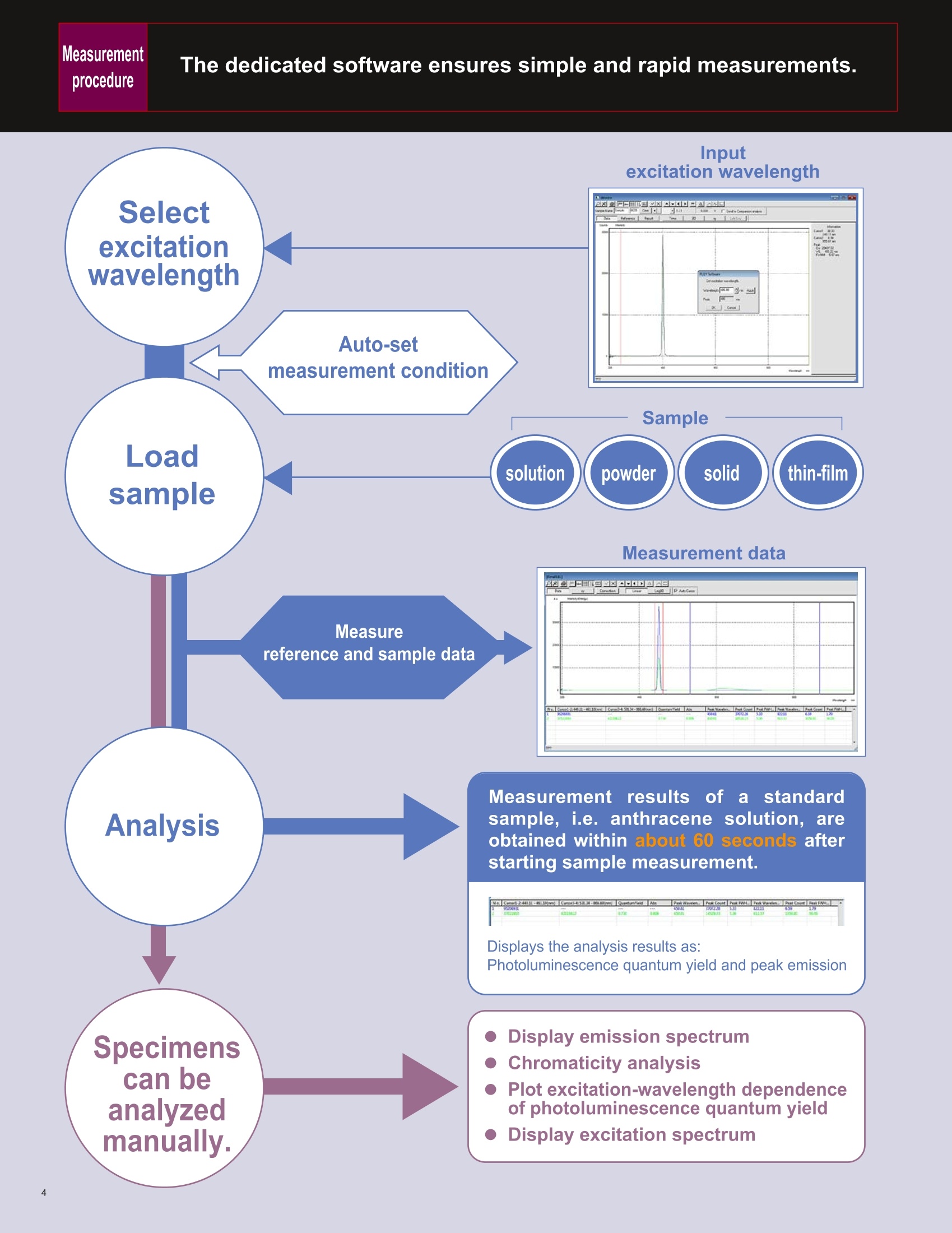

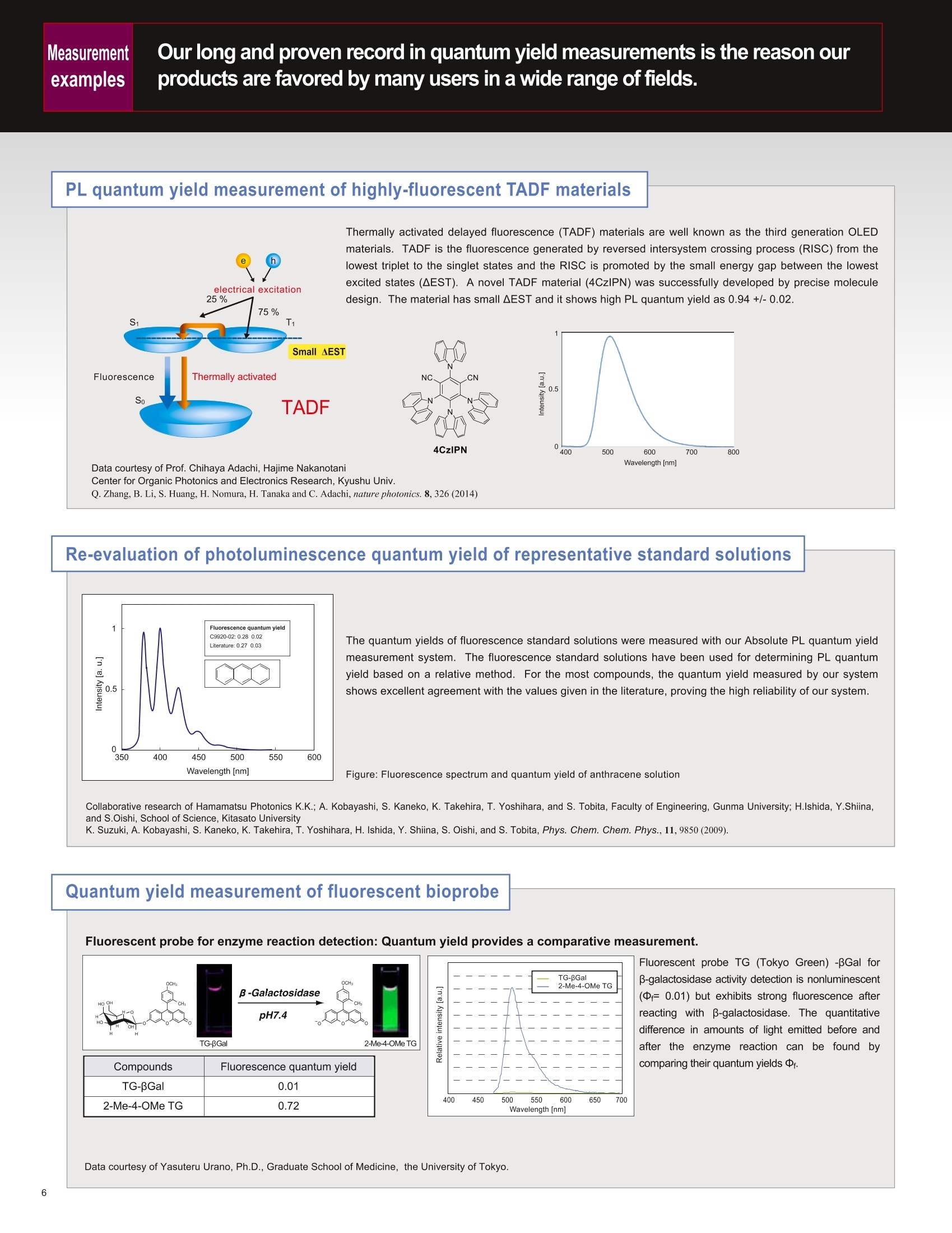
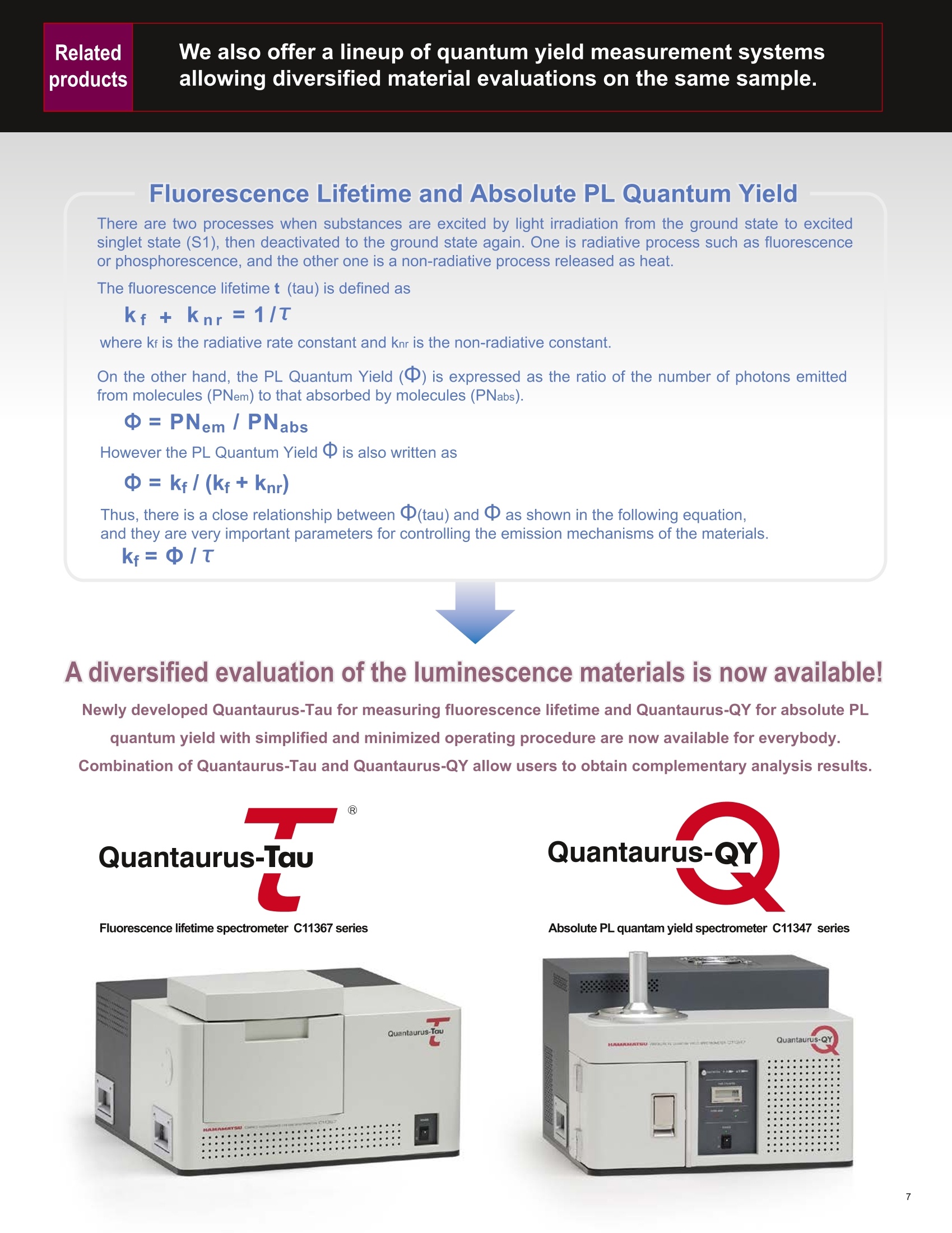
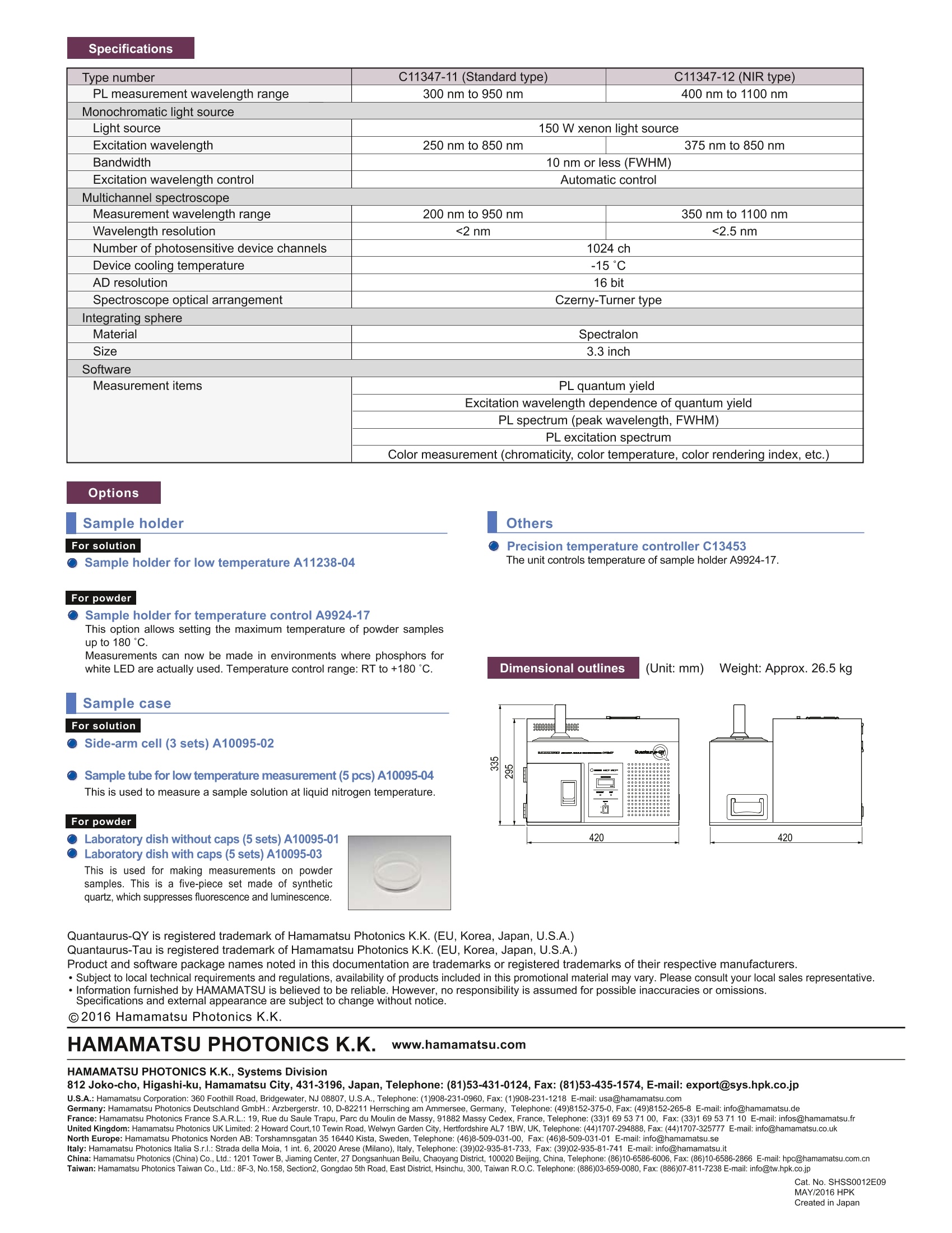
还剩6页未读,是否继续阅读?
北京睿光科技有限责任公司为您提供《量子点中量子产率检测方案(光纤光谱仪)》,该方案主要用于其他中表征检测,参考标准--,《量子点中量子产率检测方案(光纤光谱仪)》用到的仪器有PMA-12光子多通道光纤光谱仪 C10027-01、滨松近红外量子效率测试系统C13534系列、滨松量子效率测试系统 C11347系列
推荐专场
相关方案
更多






